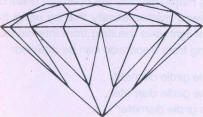Until the beginning of this century the forms of diamond cuts developed empirically. as men strove to attain an optimal brilliance effect. Only since about 1910 have theoretical calculations been employed which take into consideration the optics-physical properties of diamond - such as light refraction, dispersion, and hardness - in order to achieve maximum brilliance through suitable proportions and symmetry ratios.
The results are given in the order of their development:
 |
Tolkowsky
Brilliant (1919 - Tolkowsky) height of crown 16.2% of the girdle diameter depth of pavilion 43.1% of the girdle diameter diameter of table 53.0% of the girdle diameter crown/pavilion height 1 : 2.6 |
| Fig 195 Tolkowsky Brilliant | |
| This cut is regarded in America as "ideal" and is the basis of cut-grading, its brilliance fulfils the highest requirements. | |
 |
Ideal
Brilliant (1926 - Johnson and Roesch) height of crown 19.2% of the girdle diameter depth of pavilion 40.0% of the girdle diameter diameter of table 56.1% of the girdle diameter crown/pavilion height 1 : 2.0. |
| Fig 196 Ideal Brilliant | |
| The measurements of this cut take into consideration only light falling perpendicularly on the stone; on the other hand, no account is taken of light entering slantwise. So no great brilliance can be expected from this form of cut. | |
 |
Practical
Fine Cut (1939 - Eppler) height of crown 14.4% of the girdle diameter depth of pavilion 43.2% of the girdle diameter diameter of table 56.0% of the girdle diameter crown/pavilion height 1 : 3.0 |
| Fig 197 Practical Fine Cut |
In examining well cut brilliants with exceptional brilliance and "fire", EPPLER found in 1939 that the cutters preferred quite definite measurements and size ratios. This form of cut, originating from practice, was therefore designated the "Practical Fine Cut". Its measurements were calculated so that even light entering slantwise was taken into account. The Practical Fine Cut departs considerably from the Ideal brilliant, but only slightly from the Tolkowsky cut; it shows a few improvements on the latter.
 The
Practical Fine Cut (Praktischer Feinschliff) is the preferred type of
brilliant in Germany and serves as the Standard cut for judging
proportions (Fig 198).
The
Practical Fine Cut (Praktischer Feinschliff) is the preferred type of
brilliant in Germany and serves as the Standard cut for judging
proportions (Fig 198).
 |
Parker
Brilliant (1951 - Parker) height of crown 10.5% of the girdle diameter depth of pavilion 43.4% of the girdle diameter diameter of table 55.9% of the girdle diameter crown/pavilion height 1 : 4.13 |
| Fig 199 Parker Brilliant | |
| This cut form is quoted only for the sake of completeness. It is not of great importance in relation to the brilliance effect, as the crown is too shallow. | |
At the end of the sixties, with the publication of. the Scandinavian Diamond Nomenclature. the "Scandinavian Standard Brilliant" first became known, its values also resulting from practice. TILLANDER calculated from a great many brilliants found on the market whose brilliance effect seemed to him outstanding, and obtained the following standard data:
| Scandinavian Standard Brilliant (1969) (Fig 200) |
| height of crown 14.6 % of the girdle diameter
depth of pavilion 43.1 % of the girdle diameter diameter of table 57.5 % of the girdle diameter crown/pavilion height 1 :2.95 |
 |
| Fig 200 Scandinavian Standard Brilliant - Proportions |
Eulitz Brilliant
(1972 - Eulitz)
In 1972 W. R Eulitz's work "Determining mathematically the optimum
brilliance of brilliants" appeared, in which he showed mathematically
that by using the proportions set out below a maximum of light yield
resulting from internal total reflection and an optimal color
scattering from dispersion can be attained:
| height of crown | 14.45 % of the girdle diameter |
| depth of pavilion | 43.15 % of the girdle diameter |
| diameter of table | 56.6 % of the girdle diameter |
| crown/pavilion height | 1 : 2.95 |
| These calculated values are very close to those empirically determined by Eppler for the Practical Fine Cut. | |
| Forms of cut of diamonds | Summary table |